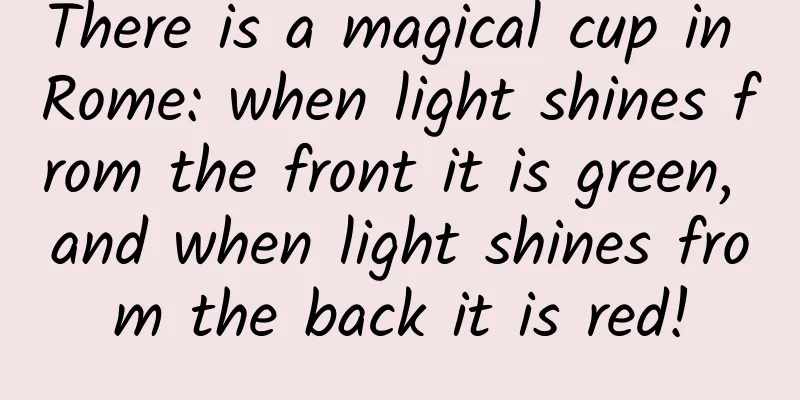There is a magical cup in Rome: when light shines from the front it is green, and when light shines from the back it is red!

|
The author or source of this article or its original publication: Bokeyuan official website: www.bokeyuan.net And mobile software: Bo Ke Yuan Scientists have developed a way to extract richer colors from the available spectrum by exploiting disordered patterns inspired by nature, which are usually seen as black. Their findings are published in the journal Nature Communications. The colors we see in nature often come from nanoscale patterns that reflect light in a specific way. For example, a butterfly's wings may appear blue because the tiny grooves on the wing surface only reflect blue light. However, when a surface appears black or white, it is usually because the structure at the nanoscale is completely disordered, causing all light to be either absorbed or reflected. A team of researchers, led by the University of Birmingham, has now found a way to control the way light travels through these disordered surfaces to produce vibrant colours. The team, which includes colleagues from Ludwig Maximilian University Munich in Germany and Nanjing University in China, compares the approach to a technique that artists have been exploiting for centuries. One of the most famous examples is the fourth-century Roman Lycurgus cup, which is made of glass and appears green when light hits it from the front. But when light shines from behind, it appears red. Now the research team has demonstrated a way to finely control this effect to produce very accurate color reproduction. The different colors in the image are represented on the lithographic plate using different thicknesses of a transparent material, such as glass. The bottom line: The researchers deposited a disordered layer, in this case, consisting of random clusters of gold nanoparticles. Finally, underneath this layer, the team placed a mirror to create a transparent cavity that is able to trap particles of light, or photons, inside. The photons behave like waves inside the cavity, resonating at different frequencies under the lithographic surface and releasing different colors depending on each wave length. By using this technique, the team was able to reproduce a Chinese watercolor painting with exquisite color accuracy. "The different ways nature produces colors are really fascinating. If we can harness them effectively, we could open up a treasure trove of richer, more vivid colors than we've seen so far," said Dr. Silvio. "In physics, we're used to thinking that randomness in nanofabrication is bad. But the researchers showed that in some specific applications, randomness can lead to structures that are superior to ordered structures. In addition, the intensity of light generated in the random structures is really strong, which could be used in other areas of physics, such as new sensing technologies." Illustration (same below): A disordered system transitioning from broadband absorption to band-limited reflection/transmission based on coupled mode theory. Disordered biological structures are ubiquitous in nature, often producing white or black due to their broadband optical response and robustness to perturbations. Through judicious design, disordered nanostructures have been realized in artificial systems with unique properties for light localization, photon transport, and energy harvesting. On the other hand, the tunability of disordered systems with broadband responses has hardly been explored. The study achieved controllable manipulation of disordered plasmonic systems, achieving a transition from broadband absorption to tunable reflection through deterministic control of coupling to an external cavity. Starting from a generalized model, it is recognized that disordered systems composed of plasmonic nanoclusters either work as broadband absorbers or have reconfigurable reflection bands in the visible light range. Studying disordered plasmonic systems is not only of great significance for further understanding of disordered physics, but also provides a new platform for various practical applications, such as structural color patterning. Bo Ke Yuan | Research/From: University of Birmingham Reference journal: Nature Communications Bo Ke Yuan | Science, technology, research, science Follow [Bokeyuan] to see more beautiful cosmic science |
<<: Coral fleece and milk fleece, I finally know how to choose!
>>: How many black holes are there in the universe? The latest number: 400 billion billion!
Recommend
Pinduoduo no-source e-commerce learning community (31 video courses in total)
Chapter 1: Overview of Pinduoduo's No-Source ...
Tonight, the Geminid meteor shower fills the sky. Where can I watch it? Can I take photos?
Tonight is the day of the annual Geminid meteor s...
Double Eleven e-commerce advertising case!
On the one hand, competition for traffic is inten...
7-year-old boy went to hospital after playing games and crossing eyes? Be careful with this kind of behavior in children!
In an era when electronic products are becoming i...
Optimization strategy for short video advertising in the tourism industry!
Summer vacation is approaching, and a new wave of...
Don’t throw away these kitchen wastes, you can eat them after hydroponics!
In the past two months, how to stock up on vegeta...
Starting from Dash iOS open source, don’t pursue perfect code too much
(Screenshot of Dash iOS source code) Some time ag...
Do we rely on Haloxylon ammodendron to find water, fix sand and strengthen virility?
Because of the Ant Forest, Haloxylon ammodendron ...
I went to Dunhuang to check in and found that Crescent Lake has become "fat"?
Science Times reporter Hu Lijuan With the Nationa...
AI can read people's minds! How long can you keep your little secrets secret?
Audit expert: Zheng Yuanpan Professor of Zhengzho...
World Stroke Day | Correctly understand stroke, and sudden death is no longer "unpredictable"
Author: Wang Huiping, Wan Shan, Wang Yanhua, Scho...
If you encounter these situations during the Spring Festival, it is recommended to call the police immediately! ! !
One minute with the doctor, the postures are cons...
What are these stars "eating"? Hubble has the answer
The starry sky is mysterious, beautiful, and out ...









